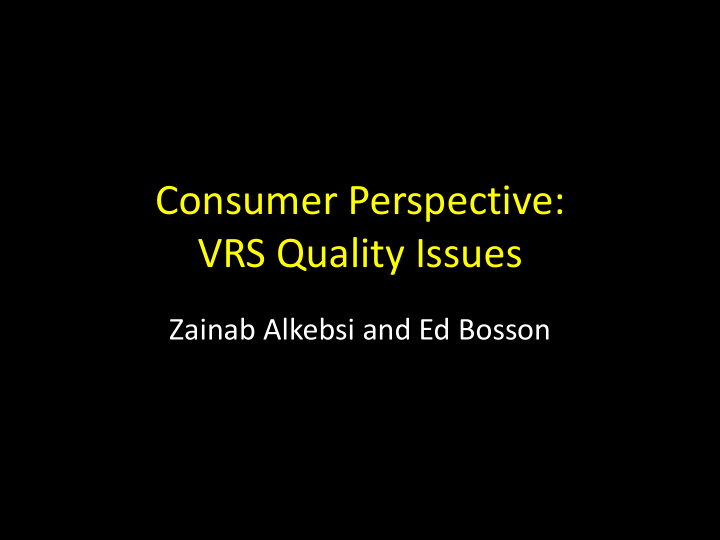



Consumer Perspective: VRS Quality Issues Zainab Alkebsi and Ed Bosson
Disclaimer • Ed Bosson – clarifying role as presenter
Role of VRS • Signing deaf and hard of hearing (D/HOH) communities depend on VRS for daily functions such as: – Employment – Family Relations – Professional Services • Lawyers • Medical professionals • Engineers – Ordering food – Many aspects of daily lives
Importance of VRS • VRS is supposed to provide telecommunications access for D/HOH functionally equivalent to what hearing persons enjoy • Quality of VRS is critical and if poor: – Breakdown of communication • Misdirection/misunderstanding of intention • Conveys bad impression of the VRS caller – Not just bad impression but also economic impact for deaf-owned businesses
Impact of Rates on Quality • As a result of the reduction in the glide path rates, the average speed of answer has declined. – The more interpreters there are, the faster the response (more $$) – The less interpreters there are, the slower the response (less $$) • Interpreters overworked (understaffed and less breaks) and paid lower = lower quality
Quality Issues • Lack of skills-based routing for specialized interpreters/better accuracy – Medical, legal, technical, CDIs, etc – Many D/HOH users feel the need to “dumb down” the conversation so that the video interpreter (VI) can follow what is being said – Causes incorrect impression on the hearing caller’s end; makes deaf caller look incompetent (especially for D/HOH professionals) • Many D/HOH users often ask to switch interpreters = delay – Grassroots D/HOH callers may not understand VIs alone and need CDI as part of the team
Logical? • Illogical to expect VRS providers to maintain/improve the level of services with less money • Cost of training the interpreters affects the quality of interpreting – Not enough funds, then training aspect is minimized and quality suffers
Problems with Porting • Process to port a telephone number from one VRS provider to another not functionally equivalent • The delay in the process exceeds the delays by other telephone users • Transfer of VRS user’s address book problematic • The potential of RUE standards • It is part of the funding issue
Need for Metrics • Need metrics to verify quality of VIs: – Script testing (done by video, for voicing and signing) • Script cannot be known to VRS providers • To be conducted by third-party entity – and developed by acknowledged test experts and consumer advocates – To ensure appropriate test scripts are used • Test scripts follow a natural telephone conversation • Funding necessary – User quality rating of each call • Option to select 1 to 5 stars at the end of the call
GAO Report • Supports what we have urged all along • Lack of specific TRS performance goals – Extremely difficult to do in an objective, quantifiable way – Difficult for FCC to manage the program in a proactive, result-oriented manner – Such performance cannot be mandated on top of cuts with already low rates – Only with a rate freeze - can take stock of performance goals
Conclusion • GOAL is improvement, not deterioration
VRS Rate Cuts & Impact Last 3 Years and Projection for the Next 3 Years
Last Three Years • Reduction in glide path rates impacted and weakened the following: – ADA mandate of functional equivalence became problematic – Longer average Speed of Answer due to less availability of VIs – Stresses on interpreters increased – Quality of communication with inferior VIs • D/HOH users look incompetent – # of Complaints from DHOH users increased • Based on feedback from consumers/NAD members
Projection of Future if Rates Continue Downward • Will continue to worsen if rates continue to be reduced – Decreasing quality of VIs – Decreasing number of innovations • Both in products and services • Problematic tunnel vision on cutting costs – Impacts ALL aspects of VRS providers = quality directly affected
Possible Solutions? • Fiscal efficiency is important BUT other factors to consider • Re-visit allowable and non-allowable expenses of VRS to be included in the calculation of VRS rates such as: – R&D in: • New products • New services • Better & improved system/programming • Etc – Outreach
Possible Solutions? (cont.) • Realize that TRS is not same as mainstream telecommunications services because of: – Labor-intensive – Involves D/HOH = at a disadvantage – ADA mandated • Telecommunications ACCESS • Functional equivalence • Need to put incentives in the rates – E.g. compensate VRS companies based on metrics
Questions • Consumers do not have access to financial data = unable to determine specific appropriate rates • Instead, we urge the Council to have better access to data provided by VRS providers and query the fund administrator on various calculation formulas: – Where did the determination to draw the tier line at 5OOK minutes per month come from? – What is the formula to determine the average cost per minute? (ordinary average or weighted average?)
Conclusions • Quality and innovative products/services dependent on ample funds • VRS industry needs competition – must have enough funds to support that – Rates should be attractive enough for new companies to join in • Allow more choices and foster competition • Rates should reward quality service and features (tied to metrics).
Recommend
More recommend